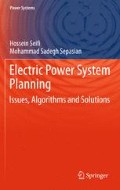Abstract
As detailed in Chap. 5, GEP is, in fact, the process of determining the generation requirements for a system so that the loads can be satisfied in an efficient (typically the most economical) manner while various technical or non-technical constraints are met. The approach presented in Chap. 5 was based on single bus representation of the system. In other words, we basically ignored the transmission system and found out the total generation requirements based on an optimization model.
Access this chapter
Tax calculation will be finalised at checkout
Purchases are for personal use only
Notes
- 1.
Think of an alternative index in which the number of generation units is, somehow, accounted for.
- 2.
γ is the average cost per unit length of a line.
- 3.
b i is expressed in terms of loading of an overloaded line. If for instance, the capacity of a line is 200 MVA and its loading is 240 MVA, b i is 1.2.
References
Billinton R, Allan RN (1996) Reliability evaluation of power systems, 2nd edn. Plenum Press, New York
International Atomic Energy Agency (IAEA) (2001) Wien automatic system planning (WASP), user manual. www-pub.iaea.org/MTCD/publications/PDF/CMS-16.pdf
Montfort B, Lederer P (1986) Generation planning at Électricité de France—a sharper focus for the coming decades. Int J Electr Power Energy Syst 8(2):75–92
Sevilgen SH, Erdem HH, Cetin B, Akkaya AV, Dağdaş A (2005) Effect of economic parameters on power generation expansion planning. Energy Convers Manage 46(11–12):1780–1789
Park YM, Park JB, Won JR (1998) A hybrid genetic algorithm/dynamic programming approach to optimal long-term generation expansion planning. Int J Electr Power Energy Syst 20(4):295–303
Antunes CH, Martins AG, Brito IS (2004) A multiple objective mixed integer linear programming model for power generation expansion planning. Energy 29(4):613–627
Ramos A, Perez-Arriaga IJ, Bogas J (1989) A nonlinear programming approach to optimal static generation expansion planning. IEEE Trans Power Syst 4(3):1140–1146
Murugan P, Kannan S, Baskar S (2009) NSGA-II algorithm for multi-objective generation expansion planning problem. Electr Power Syst Res 79(4):622–628
Kannan S, Slochanal SMR, Subbaraj P, Padhy NP (2004) Application of particle swarm optimization technique and its variants to generation expansion planning problem. Electr Power Syst Res 70(3):203–210
Kandil MS, Farghal SA, Abdel-Aziz MR (1992) Knowledge base of an expert system for generation expansion planning. Electr Power Syst Res 23(1):59–70
Zhu J, Chow M (1997) A review of emerging techniques on generation expansion planning. IEEE Trans Power Syst 12(4):1722–1728
Kannan S, Slochanal SMR, Padhy NP (2005) Application and comparison of metaheuristic techniques to generation expansion planning problem. IEEE Trans Power Syst 20(1):466–475
Pereira MVF, Pinto LMVG, Cunha SHF, Oliveira GC (1985) A decomposition approach to automated generation/transmission expansion planning. IEEE Trans Power Apparatus and Syst PAS-104(11):3074–3083
Li W, Billinton R (1993) A minimum cost assessment method for composite generation and transmission system expansion planning. IEEE Trans Power Syst 8(2):628–635
Samarakoon HMDRH, Shrestha RM, Fujiwara O (2001) A mixed integer linear programming model for transmission expansion planning with generation location selection. Int J Electr Power Energy Syst 23(4):285–293
Liu G, Sasaki H, Yorino N (2001) Application of network topology to long range composite expansion planning of generation and transmission lines. Electr Power Syst Res 57(3):157–162
Ramachandran K, Sharma JD (1978) A method for generation and transmission planning. Comput Electr Eng 5(2):171–178
Murugan P, Kannan S, Baskar S (2009) Application of NSGA-II algorithm to single-objective transmission constrained generation expansion planning. IEEE Trans Power Syst 24(4):1790–1797
Sepasian MS, Seifi H, Foroud AA, Hatami AR (2009) A multiyear security constrained hybrid generation-transmission expansion planning algorithm including fuel supply costs. IEEE Trans Power Syst 24(3):1609–1618
The references addressed for this chapter are the same as those introduced in Chap. 5. [1] is a reference book about power system reliability evaluation. [2] introduces WASP, the package developed by IAEA for GEP. [3] covers some practical issues for GEP in France at the time of publication. The economic parameters affecting GEP are discussed in [4]. Some mathematical based algorithms for GEP are covered in [5–7], while some non-mathematical based ones are introduced in [8–10]. Review and comparison of these algorithms are given in [11, 12]. If GEP and TEP are to be analyzed together, the problem becomes highly complex. Some algorithms are covered in [13–19].
Author information
Authors and Affiliations
Corresponding author
Rights and permissions
Copyright information
© 2011 Springer-Verlag Berlin Heidelberg
About this chapter
Cite this chapter
Seifi, H., Sepasian, M.S. (2011). Multi-bus Generation Expansion Planning. In: Electric Power System Planning. Power Systems. Springer, Berlin, Heidelberg. https://doi.org/10.1007/978-3-642-17989-1_6
Download citation
DOI: https://doi.org/10.1007/978-3-642-17989-1_6
Published:
Publisher Name: Springer, Berlin, Heidelberg
Print ISBN: 978-3-642-17988-4
Online ISBN: 978-3-642-17989-1
eBook Packages: EngineeringEngineering (R0)

